Steve Holliday, CEO National Grid: “The idea of large power stations for baseload is outdated”
Steve Holliday, CEO of National Grid, the company that operates the gas and power transmission networks in the UK and in the northeastern US, believes the idea of large coal-fired or nuclear power stations to be used for baseload power is “outdated”. “From a consumer’s point of view, the solar on the rooftop is going to be the baseload. Centralised power stations will be increasingly used to provide peak demand”, he says, in an exclusive interview for World Energy Focus, a publication of the World Energy Council produced by Energy Post. The chief of National Grid also notes that energy markets “are clearly moving towards much more distributed production and towards microgrids”.

National Grid’s Dorcester Solar Project, which generates nearly 1,500 MWh annually
“This industry is going through a tremendous transformation. We used to have a pretty good idea of what future needs would be. We would build assets that would last decades and that would be sure to cover those needs. That world has ended. Our strategy is now centred around agility and flexibility, based on our inability to predict or prescribe what our customers are going to want.”
As CEO, since 2007, of a company active on two continents, and being responsible for both gas and electricity transmission and distribution, Steve Holiday finds himself smack at the centre of the whirlwind developments in the energy sector. And since National Grid is a regulated (albeit publicly listed) company, he can speak from a reasonably independent position. Which makes it fascinating to talk to him.
“What is crucial”, says Holliday, “is what consumers will want. In the past all consumers got the same. One size fits all. Now one size will not fit all. People will want to interact with energy in many different ways.” This is why he warns against people who think they can predict the future. “Some people think they have the answer, whatever it may be. But I believe there will be different answers for different places, rural and cities, and for different customers. That’s why flexibility and agility are key.”
